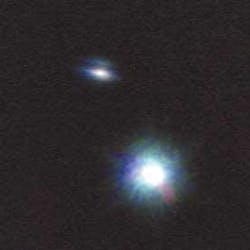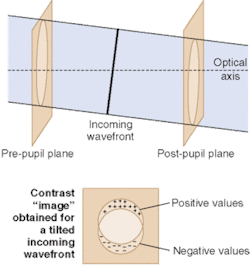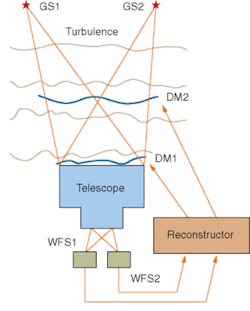Improved resolution and image coherence enables larger telescopes as well as telescope interferometers.
Wavefront sensing for adaptive optics (AO) has become an essential component in building large ground-based telescopes and telescope interferometers for 21st century astronomy. The adaptive-optics systems on these large telescopes generally use one of three different approaches to measure wavefront deviations caused by atmospheric turbulence—Shack-Hartmann, curvature, or pyramid wavefront sensing. All three methods require low-noise and fast detectors, and numerous new detector approaches and developments are being explored to enhance the performance of wavefront sensors. These approaches include low-light-level CCDs, new output-amplifier designs, novel pixel-geometry designs to tailor the detector to the application, ASIC (application specific integrated circuits) developments, and wavefront sensors for the IR (see "Low-light CCDs compete with APDs for wavefront sensing applications," p. 78).
The adaptive-optic concept was first proposed for astronomical applications in 1953, but most of the initial technology was developed for military applications.1 The Shack-Hartmann sensor was originally developed in response to a U.S. Air Force need in the late 1960s to improve images of satellites taken from Earth and is currently the most widely used adaptive-optics sensor. It splits the wavefront into numerous subregions, each forming an independent image, and measures the wavefront gradient based on the positions of the images of the reference star given by each subpupil (see "Laser guide star enables observation," p. 79). Wavefront corrections are accomplished by deforming a segmented mirror using individual piezoelectric or electrostatic actuators.2
The curvature wavefront sensor was proposed about 20 years after Shack-Hartmann as a low-order, high-efficiency alternative to the numerous mirror segments and actuators required for Shack-Hartmann systems. The sensor basically compares levels of illumination in two, out-of-focus, beam cross sections that are symmetrical on either side of the telescope focal plane. Comparing the two images yields an "image" of the curvature, as well as a slope value for the incoming wavefront. Unlike Shack-Hartman, which measures the gradient of wavefront distortion, curvature sensors measure the Laplacian (see Fig. 1). Wavefront corrections are accomplished through application of Zernicke polynomial corrections to a bimorph adaptive mirror made of two bonded piezoelectric plates. Precursors to this approach included fast tip-tilt correctors with only two Zernicke modes (x and y tilt) used exclusively to correct for image motion induced by atmospheric turbulence.3
In 1995, two of the pioneer astronomical adaptive-optics systems—the Adaptive Optics Near Infrared System (ADONIS), a Shack Hartmann device on the European Southern Observatory (ESO)–La Silla 3.6-m telescope in the Chilean Andes, and a University of Hawaii 13-element curvature system on the 3.6-m Canada-France-Hawaii Telescope (CFHT) on Mauna Kea, Hawaii—were both used to observe Saturn as Earth was crossing the ring plane. They provided, in addition to a better understanding of ring structure, the very first images of Pandora, a moon of Saturn with a diameter of only 100 km.
ADONIS has since been decommissioned from the ESO's Chilean AO pantheon, which now includes a Shack-Hartmann Nasmyth Adaptive Optics System (NAOS) supporting a near-IR imager and spectrograph; a SINgle Far Object Near-infrared Investigation (SINFONI) 60-element curvature AO system serving a near-IR integral field spectrograph; and a Multi Application Curvature Adaptive Optics (MACAO) 60-element curvature AO for the very large telescope interferometer (VLTI).4 The University of Hawaii's 13-element curvature prototype has since been replaced with Hokupa'a ("immovable star" in Hawaiian), a 36-element AO system that was first operated in 1997 at the f/36 Cassegrain focus of the CFHT and moved in 1999 to the 8-m Gemini North telescope also on Mauna Kea.
Proposed around the time of the pioneering AO astronomical achievements with curvature and Shack-Hartmann devices, the pyramid wavefront sensor combines the linear gradient simplicity of Shack-Hartmann measurements with the sampling and gain-adjustment flexibility of curvature sensing. It consists of a zoom-lens relay and an oscillating pyramid-shaped prism that projects four images of the pupil on a single detector (see Fig. 2). The zoom lens facilitates adjustment of spatial sampling for factors such as wavelength and guide star brightness, while the gain of the sensor can be adjusted through the oscillation amplitude.
The overall concept is similar to modulation contrast microscopy, and has been implemented in the AO module of the 3.6-m Telescopio Nazionale Galileo (TNG) at the Roque de los Muchachos Observatory, on the island of La Palma.5 In 2001, two components of a double star (separation on the order of 0.2 arcsec) were resolved using a pyramid wavefront sensor at TNG for the first time. And the first diffraction-limited images were achieved the following year.6
The first AO system on a very large telescope was the Shack-Hartmann facility on the 10-m Keck II telescope on Mauna Kea, which saw first light in 1999 and obtained images of the planet Neptune in 2000, showing an upper atmosphere full of moving features such as vortices, waves and narrowly spaced bands of clouds similar to those present around Jupiter. First light for the laser guide star on that system was achieved last year (see photo, p. 77). Also, as ground-based telescopes continue to grow into the proposed extremely and overwhelmingly large range of 30- to 100-m highly segmented mirrors, the alignment and AO wavefront functions are likely to be performed by separate devices, because the alignment systems will need to accommodate much larger wavefront errors (at much lower bandwidth) than the corresponding AO systems.7 A Multi Conjugate Adaptive Optics (MCAO) system using multiple laser guide stars to perform astronomical tomographic imaging similar to medical tomographic imaging is under development at the ESO to support development of an "overwhelmingly large" 100-m telescope (see Fig. 3).
Currently, the improved image coherence provided by adaptive optics is enabling the coupling of large optical telescopes into interferometric arrays. Large optical interferometers, previously only feasible for small, specially designed telescopes, have become a reality in the Keck Imaging Interferometer and the ESO's MACAO-VLTI. The two Keck telescopes were combined for the first time in 2001 as an interferometer with the angular resolution of an 85-m telescope, and last year the first published observations included the inner regions of the NGC 4151 galaxy, 40 million light years from Earth.8 The ESO achieved first light for the first of four MACAO-VLTI units, one for each of four 8.2-m VLT units, last year also. Eventually combining images between two ESO very large telescopes separated by 100 m will essentially provide the angular resolution of a 100-m telescope.
REFERENCES
- F. Roddier, M. Northcott, J. E. Graves. Publications Astronomy Soc. of the Pacific 103, 131 (January 1991).
- B. C. Platt, R. Shack, J. Refractive Surgery 17, S573 (September/October 2001).
- www.ifa.hawaii.edu/ao/
- www.eso.org/projects/aot/
- Riccardi, N. Bindi, R. Raggazoni et al, Proc. SPIE 3353, 941 (March 1998).
- www.tng.iac.es/instruments/adopt/adopt.html
- G. Chanan. celt.ucolick.org/reports_notes.html, 42 (September 2002).
- www2.keck.hawaii.edu/optics/ao/index.html
Low-light CCDs compete with APDs for wavefront-sensing applications
Improvements in low-light charge-coupled-device (CCD) technology have enabled ESO researchers to develop a CCD-based curvature wavefront sensor, which is rapidly approaching first light on the curvature-sensing Pueo (Hawaiian for owl) adaptive-optic system on the 3.6-m Canada-France-Hawaii Telescope (CFHT).1 PUEO is being upgraded from a 19-element system to a 105-element PUEO NUI.2 "This is relatively high-order AO for a 3.6-m telescope with the goal of producing diffraction-limited images in the red part of the visible spectrum," said Reinhold Dorn, an ESO physicist, specializing in detector development.
Avalanche photodiodes (APDs) have been traditionally used as wavefront sensors in low-light-level curvature adaptive-optics systems, because APDs have no readout noise and readout is almost instantaneous. Current CCD performance levels have advanced to the point, however, at which they can achieve nearly the same performance as APDs at a fraction of the cost while offering much greater dynamic range and significantly higher quantum efficiency. In one sensor, the CCD-based curvature configuration combines high-order curvature sensing with the possibility of separate tip/tilt sensing, Dorn said.
Dorn is also working on sensors for infrared wavelengths, such as indium antiminide (InSb) and mercury cadmium telluride (HgCdTe) for scientific applications, astronomical instruments and interferometry. For a given AO correction, atmospheric turbulence has a weaker effect on longer wavelengths. So the spatial and temporal sampling of the disturbed wavefront can be reduced, which in turn permits the use of fainter reference stars. The field of view over which the reference star can provide effective corrections for atmospheric wavefront distortions (the isoplanetic angle) is also larger in the IR than in the visible.
REFERENCES
- J.-C. Cuillandre, J. Beletic, R. Dorn et al., Proc. "Workshop for Scientific Detectors for Astronomy, Waimea, Hawaii, June 16–22, 2002"; eds. P. Amico, and J.W. Beletic; Kluwer Academic Publishers (2002).
- www.cfht.hawaii.edu/Instruments/Imaging/AOB/
Laser guide star enables observation
A plane wave traveling through 20 km of typical atmospheric turbulence accumulates phase errors on the order of microns as measured across the diameter of a large telescope, resulting in blurred images. Compensating for these phase errors requires that they be sensed every millisecond or so and corrected with an accuracy on the order of 0.02 microns.
The wavefront sensing required as a first step to compensating for atmospheric turbulence is done on a reference star, or on the observed object if it is bright enough. Atmospheric wavefront distortions are correlated with the reference within a very limited field of view, isoplanatic angle, on the order of a few arcsecond for visible wavelengths. To get around this limitation, artificial reference stars, also referred to as laser guide stars (LGS), can be created and positioned in close proximity to the astronomical target by the back-scattering of pulsed laser light either from sodium atoms in the high mesosphere or molecules and particles in the low stratosphere. The laser beam is focused at an altitude of about 90 km for sodium resonance and at 10 to 20 km Rayleigh diffusion in the low stratosphere.
The Adaptive optics with a Laser For Astronomy (ALFA) system on the 3.5-m telescope at the Calar Alto observatory (Spain), an astronomical pioneer in the dedicated use of a laser-guide-star projector, is installing a pyramid wavefront sensor in the existing Shack-Hartmann system this year. In 1997, the LGS enabled the observation of a previously unresolved pair of stars in the constellation Perseus thought to harbor a young, protoplanetary system. The first diffraction-limited images were obtained in 1999.1
REFERENCE
- www.mpia-hd.mpg.de/AO/INSTRUMENTS/PYRAMIR/pyramirMain.html




